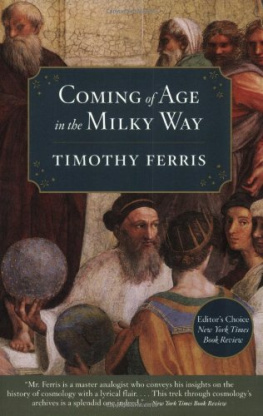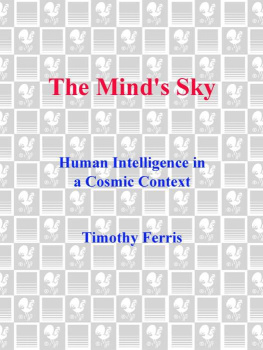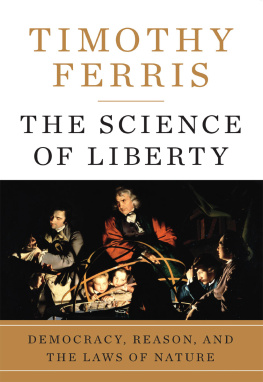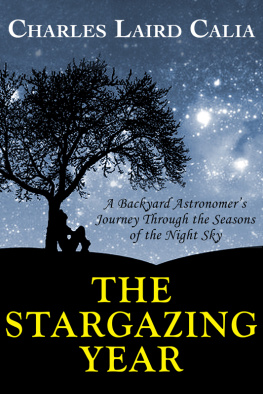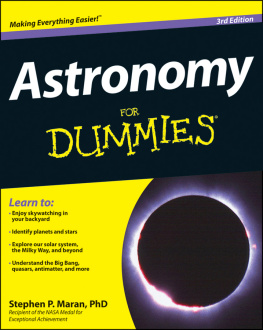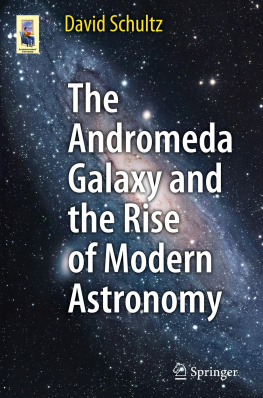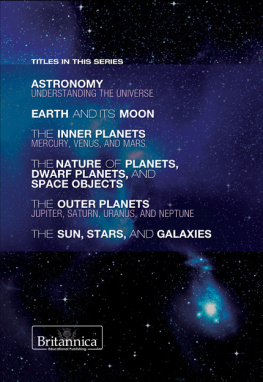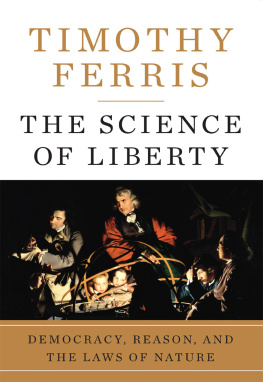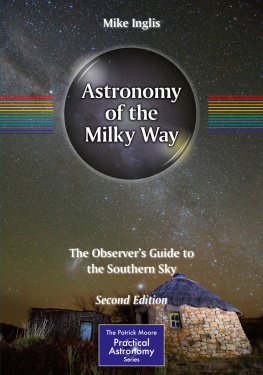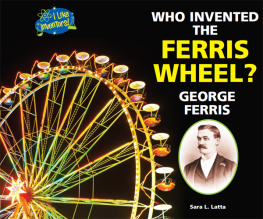Thank you for purchasing this Simon & Schuster eBook.
Join our mailing list and get updates on new releases, deals, bonus content and other great books from Simon & Schuster.
C LICK H ERE T O S IGN U P
or visit us online to sign up at
eBookNews.SimonandSchuster.com
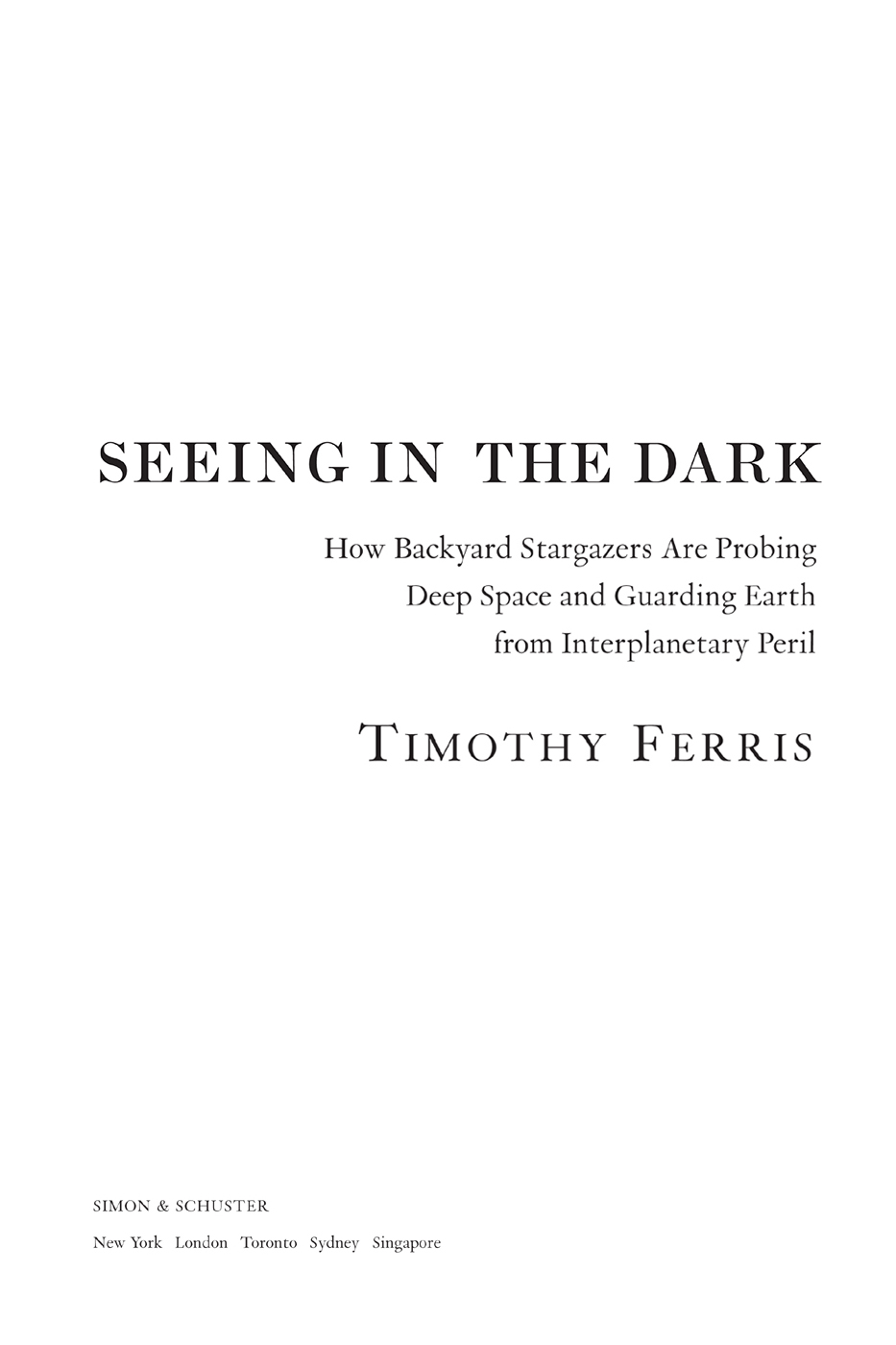
To stargazers everywhere
Rapport of Sun, Moon, Earth, and all the constellations,
What are the messages by you from distant stars to us?
Walt Whitman
Anywhere is the center of the world.
Black Elk
CONTENTS
I:
THE SHORE
From the Observatory Log:
A Primate at Dusk
Standing Watch:
A Visit with Mr. White Man
How Much Can You See?
A Visit with Stephen James OMeara
Picturing the Universe:
A Visit with Jack Newton
Farsighted:
A Visit with Barbara Wilson
II:
BLUE WATER
Rock Music of the Spheres:
A Talk with Brian May
Founding Father:
A Visit with Patrick Moore
The Telescope and the Tomb:
A Visit with Percival Lowell
Light at the Edge of Darkness:
A Visit with James Turrell
Comet Trails:
A Visit with David Levy
The Cameras Eye:
A Visit with Don Parker
Storms on Saturn:
A Visit with Stuart Wilber
From the Observatory Log:
Chimes at Midnight
III:
THE DEPTHS
Digital Universe:
A Virtual Visit to a Robotic Telescope
Blues Line:
A Visit with John Henrys Ghost
Big Science:
A Visit with Edgar O. Smith
From the Observatory Log:
Minerva at Dawn
PREFACE
We grow accustomed to the Dark
When Light is put away
As when the Neighbor holds the Lamp
To witness her Goodbye
...
Either the Darkness alters
Or something in the sight
Adjusts itself to Midnight
And Life steps almost straight.
Emily Dickinson
To gaze is to think.
Salvador Dal
T HIS BOOK IS ABOUT STARGAZING , which is at once one of the oldest and most ennobling, and one of the newest and most challenging, of human activities. It weaves togetheror entangles, insofar as my efforts have been less than felicitousthree strands.
The first is an account of my own experiences as a lifelong stargazer, principally the experience of what happens in the moment when ancient starlight strikes the eye and incites the mind. These encounters, involving as they do the inconceivably remote and the deeply intimate, have meant so much to me that it seemed inadequate to describe them solely through the eyes of others.
The second is a report on the revolution now sweeping through amateur astronomy, where depths of the cosmos previously accessible only to professionals or to nobody at all have been brought within the reach of observers motivated simply by their own curiosity. Many of these amateurs are content to enjoy the aesthetics of the cosmic spectacle. A few labor at what amount to unpaid careers as research scientists, a situation that raises the question of just what constitutes an amateur. Perhaps the best definition was offered by
The third strand has to do with whats out therewhat Saturn, the Ring nebula, the Silver Coin galaxy, and the CorBor cluster really are, as best we humans can tell at this early stage in our cosmic investigations. Much remains to be learned, but in studying the starsas in attending a concert, or watching a baseball game, or talking with an old friendit helps to know a few things about the objects of your attention and affection.
Although this book is not intended to be a how-to manual of amateur astronomy, I hope that it will encourage its readers to make the glories of the night sky a part of their lives. The universe is accessible to all, and can inform ones existence with a sense of beauty, reason, and awe as enriching as anything to be found in music, art, or poetry. No great familiarity with astronomy is required to read these pages, and readers encountering an unfamiliar term are encouraged to make use of the glossary. For those who wish to try their hand at stargazing, , Observing Techniques, offers suggestions on getting started.
Casual observing of the stars and planets requires as little effort as casual bird watching, but serious amateur astronomers devote considerable time and effort to their avocationnot to mention lost sleepand it seems reasonable to ask why they do it. I have asked many of them this question, only to find that most, like myself, simply got sensitized to stargazing at some point and stuck with it, for reasons they find as difficult to explain as why they married their spouse rather than someone else. Some mention the beauty of the planets, stars, nebulae, and galaxies. Others invoke the grandeur of the cosmos and their sense of belonging to it. A few mention that contemplation of the stars draws people closer to one another, by awakening us to our common status as fellow travelers on one small planet. As a Chinese amateur astronomer, Xie Renjiang, of Dalian, wrote me recently, Astronomy is the most significant [way to] unify us. Although we have different skin colors and live in different countries, we should all be the family on this planet. No other cause is so noble in my eyes.
As this is a narrative work rather than an academic review, many estimable astronomers and telescope makers go unmentioned herenot through any deficiency of theirs but because they didnt happen to fit into the story as I have told it. I can only apologize for these omissions with the plea that storytelling, like the Sun in the sky, obscures as much as it reveals.
In addition to the many stargazers whose cooperation was essential to my research and whose kindness and hospitality has been a boon, I am grateful to my wife and family, and to William Alexander, Andrew Fraknoi, Edwin C. Krupp, Owen Laster, Sara Lippincott, Alice Mayhew, Leif Robinson, Donna April Chua Sy, and Terra Weikel.
Seeing in the Dark was written in San Francisco, California; in Florence and Castiglione della Pescaia, Italy; and at Rocky Hill Observatory on Sonoma Mountain, California, from 1991 to 2001. Portions of it originally appeared, in a substantially different form, in The New Yorker.
T.F.
I
THE SHORE
FROM THE OBSERVATORY LOG:
A PRIMATE AT DUSK
A T SUNSET ON A LATE AUTUMN DAY the skies have cleared, so I hike the two hundred paces from the house up the hill to the observatory. A two-day storm has scrubbed the sky clean of haze and left the fruit trees in the orchard bare, their dead leaves spread like vendors wares in soggy puddles of russet and yellow at their feet. The vineyards flanking the path are soaked, their leaves hammered into sheets of glistening gold. Lined up toward the top of the dirt path stand three farm structures, each sided in railroad-red clapboard and roofed with corrugated steel. The first is a barn, the second a tractor shed, and the third, pitched out over the hillside, is the observatory. Its roof rolls off.
Inside, I step around the cylindrical concrete pier that supports the telescope one story above. Two feet thick, rooted in bedrock far below, the pier stands at the heart of the observatory but touches it nowhere, an isolation imposed to prevent its picking up vibrations. Upstairs, I am gratified to find that the telescope, hunkered down on its concrete lily pad and safe beneath the low roof, has weathered the storm bone dry. I release a big red safety latch and heave my weight against the nearest aluminum stud. The roof emits a groan and starts rolling on its twelve steel wheels, until it has cleared away and suddenly I am outdoors again, under a promising sky of unblemished and darkening blue.
I tilt the telescope skyward and reach in through the struts of its skeleton tube to uncover the concave primary mirror, which returns a fleeting, funhouse image of my facebig, goofy jowls and diminished browas if to underscore the preposterousness of my primate pretensions, an ape out to learn about the cosmos. The mirror, wide as a serving platter and thick as a phone book, is figured in a parabola to an accuracy of better than one-eighth of the wavelength of sodium light, but until it reaches the same temperature as the surrounding air it will be somewhat warped. While waiting for the mirror to cool down, I sit at the desk, switch on a small red night-vision light ( red light, long in wavelength and relatively low in energy, minimizes dazzle to the dark-adapted eye ) , and make an entry on the ruled page of the observatory logbook: Sky cloudless. Light southwest wind. Humidity sixty-seven percent and falling.
Next page

